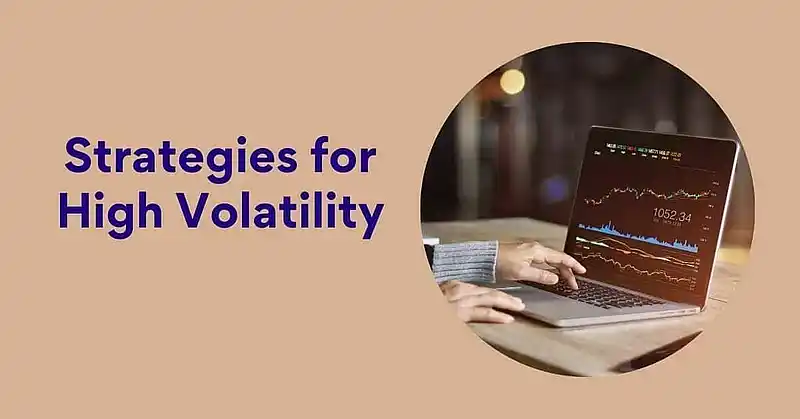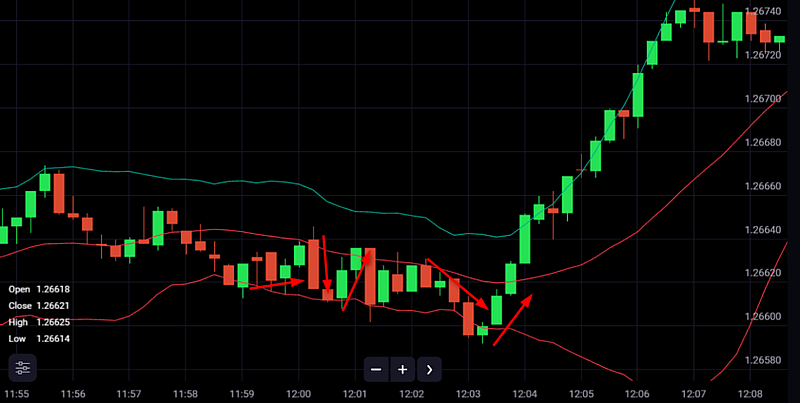Trading Volatility: How to Profit from Market Sharp Moves
Contents
Volatility is a key concept in financial markets, and it is particularly significant for binary options traders. It measures how much and how quickly the price of an asset can change. High volatility means that the price can fluctuate sharply both up and down, while low volatility indicates more stable price movements. Why is volatility important for binary options traders?
- Profit Opportunities: Volatility creates market movement, and movement presents opportunities to earn. For binary options traders, sharp price swings can mean potentially high profits if the direction of the movement is predicted correctly.
- Risk Management: Understanding volatility helps traders assess risks. In periods of high volatility, risks increase, but so do potential profits.
- Strategy Selection: The level of volatility influences the choice of trading strategy. Some strategies work better in high-volatility conditions, while others are suited for low-volatility environments.
- Expiration Time Selection: Volatility helps determine the optimal expiration time for an option. In high volatility, traders may choose shorter timeframes, while in low volatility, longer periods might be more appropriate.
- Market Movement Prediction: Analyzing volatility can help forecast potential price movements, which is critical for successful binary options trading.
- Psychological Aspect: Trading during high volatility requires calmness and discipline. Understanding volatility allows traders to better control their emotions.
Volatility is a powerful tool in the hands of an experienced binary options trader. The ability to analyze and utilize volatility can be the key to a successful trading strategy and consistent profits.

Understanding Volatility
Volatility is one of the key concepts in trading binary options and other financial markets. It reflects the degree of price fluctuation of assets and plays a crucial role in assessing risks and opportunities. Understanding volatility helps traders more accurately forecast market movements and make informed trading decisions.
Types of Volatility
- Historical Volatility: This is a measure of price fluctuation based on past movements. It is calculated using historical price data and shows how much asset prices have varied in the past. Historical volatility is useful for assessing asset stability and determining potential risks. Traders use this measure to understand how often and within what range prices have fluctuated, which can help in predicting future movements.
- Implied Volatility: This is an estimate of future price fluctuations based on current market conditions and option prices. It reflects the market’s expectations regarding future price swings of an asset. Implied volatility is often calculated using models such as the Black-Scholes model and can be used to assess the value of options and other derivatives. This metric helps traders and investors make decisions about buying or selling assets based on predictions of future volatility levels.
Factors Influencing Market Volatility
Publications of macroeconomic data (such as GDP, unemployment rates, inflation) can significantly affect market volatility. News about new economic indicators or changes in economic policy can cause sharp price fluctuations.
Political crises, conflicts, or international agreements can also impact market volatility. Uncertainty related to such events can cause significant price swings and increase volatility.
These can significantly influence the volatility of stocks and other financial instruments. Expectations regarding corporate earnings, revenue, and other indicators can cause strong price swings in the stock market.
Trading volumes and overall market sentiment can also influence volatility. For example, low liquidity can lead to sharper price swings, as large trades may have a more significant impact on the market. These can also increase volatility. Rapid reactions to market signals and automated trading strategies can cause sudden and significant price changes.
Understanding these types of volatility and the factors that influence them will help you more effectively analyze the market and make informed trading decisions. It is important to consider volatility when planning trading strategies and managing risks to make the most of market opportunities and minimize potential losses.
Tools for Measuring Volatility
Measuring volatility plays a key role in financial market analysis and making trading decisions. Several tools help assess the level of asset volatility: the Volatility Index (VIX), Bollinger Bands, and Average True Range (ATR).
Volatility Index (VIX)
The Volatility Index, or VIX, also known as the “fear index,” reflects the market’s expectations for future volatility based on options prices for the S&P 500 index. The VIX is calculated based on the implied volatility of these options and provides insights into how much the market expects price fluctuations over the next 30 days.
A high VIX value indicates expected high volatility, often associated with market uncertainty or panic. A low VIX value signals stability and low volatility. Traders use the VIX to assess risks and make decisions about entering or exiting positions.
Bollinger Bands
Bollinger Bands are a technical indicator that helps determine volatility levels and potential market reversal points. The indicator consists of three lines:
- A moving average (usually a 20-day average) in the center.
- An upper band, located a certain number of standard deviations above the moving average.
- A lower band, located the same number of standard deviations below the moving average.
When Bollinger Bands expand, it indicates increasing volatility, while contraction suggests decreasing volatility. When the asset’s price approaches the upper or lower band, it may signal overbought or oversold conditions, which could indicate a potential trend reversal.
Average True Range (ATR)
The Average True Range (ATR) is an indicator that measures volatility by analyzing price ranges over a certain period. ATR is calculated as the average of the True Range over a specific number of periods. The True Range is defined as the largest of the following:
- The difference between the current high and low.
- The difference between the current high and the previous closing price.
- The difference between the current low and the previous closing price.
ATR is used to determine volatility levels. High ATR values indicate high volatility, while low values suggest low volatility. Traders often use ATR to set stop-loss levels and assess potential risk levels.
These tools allow traders to assess market volatility and make more informed trading decisions. Understanding and properly using them can help manage risks more effectively and take advantage of market opportunities.
Trading Strategies for High Volatility
High market volatility creates both opportunities and risks for binary options traders. The right strategy can help maximize profits from sharp price movements. Let’s explore three effective strategies for trading in high volatility conditions.

Breakout Trading
Breakout trading is a strategy that takes advantage of strong price movements typical during periods of high volatility. The main idea is to open a position when the price “breaks through” a certain resistance or support level. Here’s how to apply it:
- Identify key support and resistance levels on the chart.
- Wait for the price to approach one of these levels.
- If a breakout occurs with high volume, it signals an entry point.
- Buy a Call option on a resistance breakout, or a Put option on a support breakout.
- Set short expiration times to capitalize on momentum.
Advantages: This strategy can yield high profits if the price direction is predicted correctly.
Risks: False breakouts can lead to losses, so it’s important to confirm breakouts with additional indicators.
Straddle Strategy for Binary Options
The straddle strategy is particularly effective when a strong price movement is expected, but the direction is unknown. This strategy involves simultaneously buying both Call and Put options with the same expiration. Here’s how to apply it:
- Choose an asset you believe will make a significant move (e.g., before a major news release).
- Buy Call and Put options simultaneously with the same expiration.
- If the price moves significantly in any direction, one of the options will generate a profit that exceeds the loss on the other.
Advantages: This strategy allows profit regardless of price direction.
Risks: If the price remains stable or the movement is not strong enough, both options may result in losses.
Using Short-Term Options
During periods of high volatility, short-term options can be especially profitable, as they allow quick reactions to sharp market movements. Here’s how to apply it:
- Choose options with short expiration times (from 60 seconds to a few minutes).
- Use technical analysis to identify short-term trends.
- Open positions in the direction of the trend.
- Be prepared to quickly close positions if the market direction changes.
Advantages: Quick profit potential, less time for unexpected factors to influence the market.
Risks: Requires fast decision-making and can be more stressful than long-term trading.
When using any of these strategies, it’s essential to follow risk management rules. High volatility means not only greater opportunities but also increased risks. Always use stop-losses, avoid risking more than 1-2% of capital on a single trade, and be ready to quickly adapt to changing market conditions.
Practice and constant analysis of results will help determine which strategy best suits your trading style and risk tolerance.
Low Volatility Trading Strategies
Periods of low volatility are characterized by small price fluctuations and a lack of clear trends. While these conditions may seem less attractive to traders, they also offer profit opportunities when the right strategies are employed. Let’s look at two effective strategies for trading in low volatility environments.

Range Trading
Range trading is a strategy ideally suited for low-volatility markets, where an asset’s price fluctuates between specific support and resistance levels. How to apply:
- Identify a clear price range on the chart where the price regularly bounces between support and resistance levels.
- Buy Put options (down) near the upper boundary of the range (resistance level).
- Buy Call options (up) near the lower boundary of the range (support level).
- Set an expiration time long enough for the price to reach the opposite boundary of the range.
Advantages:
- High success probability when the range is clearly defined.
- Ability to profit even when there are no strong market movements.
Risks:
- Possibility of a sudden breakout from the range, which can lead to losses.
- Patience is required as price movements may be slow.
Using Long-Term Options
In low-volatility conditions, long-term options may offer more profit opportunities as they provide more time for market movements to develop. How to apply:
- Choose options with longer expiration times (from a few days to a few weeks).
- Conduct fundamental analysis of the asset to determine its long-term price movement potential.
- Use technical analysis to identify optimal entry points.
- Open positions based on your analysis, choosing Call options for expected growth or Put options for expected decline.
Advantages:
- Less dependence on short-term price fluctuations.
- More time for the predicted movement to develop.
- Ability to use both fundamental and technical analysis.
Risks:
- Requires more capital, as long-term options are usually more expensive.
- Long waiting times for results can be psychologically challenging for some traders.
Additional Tips for Trading in Low Volatility:
- Be patient: Price movements can be slow, so don’t rush your decisions.
- Use volatility indicators: Tools like Bollinger Bands or ATR can help identify moments when volatility starts to increase.
- Watch trading volumes: Even in low volatility, increased volumes can signal potential price movement.
- Diversify: Don’t focus on a single asset, consider trading various instruments to increase your chances of profit.
- Keep an eye on news: Even during low volatility periods, important news can cause significant price movements.
Trading in low-volatility conditions requires a special approach and patience. These strategies will help you maximize your profits in calm market environments. Remember, the key to success is consistent practice and analysis of results to optimize your trading strategy.
Risk Management in Volatility Trading
Risk management is a key aspect of successful trading, especially when dealing with volatile markets. A proper approach to risk management helps preserve capital and ensure long-term profitability. Here are the three main methods for managing risks in volatility trading.

Proper Position Sizing
Determining the optimal position size is a balance between potential profit and acceptable risk levels. How to apply:
- Use the 1-2% rule: Never risk more than 1-2% of your trading capital on a single trade.
- Consider volatility: In high volatility, reduce position size to compensate for the increased risk.
- Apply a position size formula: Position Size = (Capital * Maximum risk per trade) / (Entry price – Stop-loss price).
- Adjust the position size depending on your confidence in the trade and current market conditions.
Advantages:
- Protects capital from large losses.
- Allows you to survive a series of losing trades without significant damage to your account.
- Provides psychological comfort, allowing for more objective decision-making.
Using Stop-Losses
A stop-loss is a pre-set level of loss at which a position is automatically closed. How to apply:
- Always set a stop-loss before entering a position.
- Place the stop-loss at a level that accounts for the asset’s normal volatility while protecting against excessive losses.
- Use technical analysis to determine logical stop-loss levels (e.g., below support levels for long positions).
- In high volatility, consider using wider stop-losses but compensate with a smaller position size.
- Apply a trailing stop to lock in profits as the price moves in your favor.
Advantages:
- Limits potential losses.
- Automates the risk management process.
- Improves trading discipline.
Diversification
Diversification involves spreading capital across different assets and strategies to reduce overall portfolio risk. How to apply:
- Trade different assets: currency pairs, stocks, indices, commodities.
- Use different timeframes: combine short-term and long-term strategies.
- Apply different trading strategies: trend-following, counter-trend, breakout strategies, etc.
- Consider asset correlation: choose assets with low correlation for maximum diversification.
- Spread risk: Avoid concentrating more than 20-25% of your capital in one sector or asset type.
Advantages:
- Reduces overall portfolio risk.
- Stabilizes returns.
- Allows you to profit from different market conditions.
Additional risk management tips:
- Keep a trade journal: This helps analyze your decisions and improve your risk management strategy.
- Use risk/reward ratio: Aim for trades with a ratio of at least 1:2 (potential profit twice as large as the risk).
- Consider news correlation: Be cautious when opening multiple positions that may be affected by the same news events.
- Regularly review and adapt your risk management strategy: Markets change, and your approach should evolve with them.
- Use risk analysis tools: Many trading platforms offer tools for assessing and managing portfolio risk.
Effective risk management is not just a set of rules but a mindset. It requires discipline, constant analysis, and a willingness to adapt. By applying these methods, you can significantly increase your chances of long-term success in volatile market trading.
